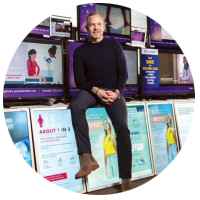Interview: How The Moment of Care Evolved During COVID-19 - June 2020
With Mark Bard and Matt McNally


The Evolving Moment of Care
An 11 minute watch. This video is a summary of a conversation between the DHC’s Founder Mark Bard and Outcome Health’s CEO, Matt McNally which took place at the end of May 2020. Mark and Matt focus their discussion on the ways that the moment of care has changed during COVID-19. Watch the video or check out the transcript below to learn more about how things trended in March – May, and what we might see next, based on Matt’s extensive knowledge of the physician office dynamics.
Video Transcript
We’ve had a very interesting March and April. We’re closing out May as we head into June here. You’ve been talking to a lot of folks. You’ve got a lot of end user clients. You’ve got a lot of clients that are on the advertising side. What are you hearing first-hand from the providers right now as we head into June?
I mean, let’s be direct. A lot of these businesses lost significant revenue almost of a full quarter. A lot of our biggest providers are – how do we ensure that we follow all the safety guidelines for our patients and as well as our physicians that come into our systems everyday but really get back to work?
A lot of the things that we are hearing from them is one, we have seen an uptick in their request for custom content. As they’re looking to stay on top of what are the best ways to handle everything COVID-19 related and not related. In terms of waiting room, we’re hearing everything from hey, we have the waiting room open. We’re practicing social distancing within that waiting room. We’re cleaning and sanitizing the waiting room, obviously, multiple times throughout the day. We’re insuring that if a patient does not come in with PPE and face mask covering that they provide it for the patient. They continue to do temperature checking, which we saw very early on within the waiting room practice.
There’s a lot of scuttlebutt around, well, we’re going to have people wait in cars. We’re not going to allow anyone in the waiting room. We’re seeing that definitely varies by geography, definitely varies by specialty, and most importantly it varies by the patient. I think we are definitely seeing much more of a return to normalcy in the past couple weeks, but with much more stringent guidelines on how they manage the ins and outs of patients coming in and out of their practices.
What we saw at first were no surprises. Obviously, significant decreases in New York, significant decreases in California as well as Washington, some of the first states that were sheltering in place. What we did see as we went through April is a fairly – not standard, but more of a similar drop with many geographies because I think the uncertainty. Even if you weren’t sheltering in place, physicians were taking it on their own to figure out how they were managing office traffic.
Even though there may have been certain areas that weren’t minding that as they were going to the grocery store or beaches, physicians wanted to make sure that ever if they weren’t sheltering in place that their number one priority was their patient’s safety. Then what we’ve seen is now a rebound back to geographical nuances, Mark, that you have said as well.
I also say that it’s also hard to look in aggregate at a specialty because not all oncology practice is the same, similar to a derm. Obviously, with some derms seeing a little bit more elective. Some of our derm offices over index on cosmetic versus biologic treatments for things like psoriasis and others, a much bigger impact return to normalcy now.
Definitely a big impact in pediatrician offices as there is a lot of uncertainty around what does this mean for children. What do we do? We did see a decrease in PED office visits as well, and similar to GI when there were a lot of scopings and things happening. If a gastro felt that they could warehouse or push off a patient for a month, we definitely saw that in April to the beginning of May.
The wall board was designed for the physician to actually interact with the device and educate the patient about what is happening. The touch is very minimal to begin with. It wasn’t a patient touch device. What we have also launched, that we actually started before COVID-19 even hit, was brining touchless technologies to not only the wallboard, which I talk about, but our ERT through QR coding.
Think about it. You pick up your mobile device. You use your camera lens just like you would to take a picture. You put that over the wall board through a backend website property. On the patient’s own device, they can now interact with content similar to if they were actually holding the physical device.
I think what we’re seeing, even when you look at everything as a consumer, it’s coming down to choice. Some people may not touch. Some people aren’t bothered at all. We believe healthcare is about choice. Now, we just want to make sure that we provide patients and providers that regardless of what their choice is, they can have a similar experience to what they had with us before.
Matt McNally: We didn’t want to jump on a bandwagon. We are a telemedicine company. As you know, there’s fully integrated systems that track everything from registering the patient to being able to track IBC-9 and 10 codes, to be able to give them content experience. What we did notice is we started to hear a lot of feedback from our providers, and a lot of feedback from patients that we were surveying that of those that were opting into use telemedicine, many of them still had wait times, and significant wait times up to ten minutes where they are staring at a blank screen and waiting for the physician to come into the practice.
As we started to talk to a lot of our providers, they were like, we’re so hungry for information. Especially the biggest systems, they’re like, we’re living at the hospital. I am living at work. A lot of them still were continuing with electives where they could. Now, they had this influx of COVID-19 patients coming into their practices.
What we started to do is repackage the wall board a little bit, which again for your knowledge is in the exam room. Historically, the physician interacts with it and uses it for patient education. We started to run HCP-focused messaging within those exam rooms, specifically to address those two needs from our pharmaceutical clients. Reps can’t get in. There are no conferences.
Physicians don’t have time. A lot of them aren’t out surfing the internet and researching like they could. They are spending much more time in the clinical setting than ever. That was our first way to, again, not create a new product, not launch something completely different, but take something that we had and deliver a new, intended use.
What was great is our pharmaceutical clients had content that they could run and get in front of physicians in a different way. I think one thing really interesting before we wrap is we’ve also been working with our agencies and manufacturers to also remind ourselves the patients that we’re serving every day. Over a decade ago, the pharmaceutical pipeline was dominated by primary care and gen meds where there would have been a much more significant impact right now to their overall revenue as well as how they were going to engage. Again, those areas now are a lot more remote care and telemedicine.
Again, I’ve had hundreds of phone calls with our providers. They had been honest with me. They’re like, Matt, I’m not going to give a terminal cancer diagnosis over a Zoom call. The physical touch and comfort that is also a physician’s job, we need to keep the patient in mind. Who is the patient that we’re serving? How do they want to interact and receive healthcare information? How do we support that dialogue between the physician and patient again?
It comes down to choice. We think it’s an and business, not an or. It’s going to be about the physical and the virtual. At different times, you’re going to select them to do different things. It’s our responsibility as healthcare marketers to have the tools set and have those choices to give all of our stakeholders. I think that’s what we keep reminding ourselves every day at Outcome Health, and what we’re trying to remind all of our partners too.
You can connect with Matt McNally on LinkedIN.
To learn more about Outcome Health, visit www.outcomehealth.com.
